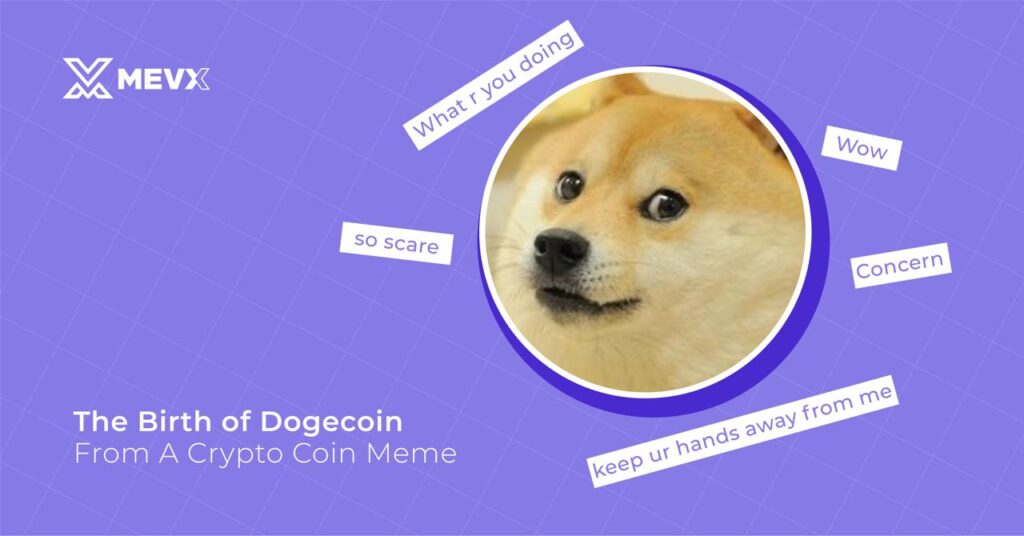While the crypto world has seen its fair share of innovations, it’s a world that truly rethinks the whole notion of finance; few have been quite as peculiar as a joke creating a whole category. A lighthearted internet crypto coin meme gave the world Dogecoin, and then the “meme coin” phenomenon exploded.

The Birth of Dogecoin From A Crypto Coin Meme
In 2013, Dogecoin was born as one big joke on the burgeoning cryptocurrency trend. Based on the popular Doge meme, a viral photo of a Shiba Inu dog with a caption in colors stating things like “such wow” and “much currency,” software engineers Billy Markus and Jackson Palmer founded Dogecoin. But whereas Bitcoin was this thing that wanted to disrupt world finance, Dogecoin was, well, a farce. Its creators never expected the thing to ever take flight, seriously.
However, it was this lightness that crypto-people just adored. Very soon, the coin began actively to develop, attracting fans of memes in general and investors of cryptocurrency in particular. Dogecoin came with a brand that was relatable and funny—much more available than other cryptocurrencies that sounded very technical and serious.

How Dogecoin Sparked the Meme Coin Movement
The success of Dogecoin wasn’t just about its meme origins; it represented something bigger. It showed that cryptocurrencies could be fun, community-driven, and powered by internet culture. This set the stage for what we now call the “meme coin” category—cryptos that rely heavily on hype, humor, and viral trends rather than practical use cases.
Unlike other typical cryptocurrencies, including Ethereum and Bitcoin, the ecosystem of meme coins is built upon creating great online communities based on jokes, memes, and proactive use of social media. Usually, the ground for the valuation of a meme coin is its popularity, not its usefulness. Crypto investors of internet memes and culture found a way to combine humor and trading.
And that’s how a crypto meme coin gives birth to the first meme coin, and later, a whole category.
The Role of Social Media and Online Communities
Social media plays an important role in the uprise of meme crypto, such as X, Reddit, and TikTok. With social media platforms, any meme coin may go viral anytime soon, where posts and hashtags go viral to attain investors in their wake. Indeed, the price increase viewed by Dogecoin in 2021 corresponded closely with the tweets by Elon Musk, a so-called “Dogefather.”
This has been a signature feature of viral marketing in the case of meme coins. Communities like r/cryptomemes on Reddit add to the excitement and trading activity, let alone X discussions. Then, there are also crypto-rich memes and crypto trading memes that have contributed to this cultural movement working to keep meme coins relevant and fun.
Beyond Dogecoin: New Meme Coins Emerge

While Dogecoin is still a leader, it really opened the doors for a great many more new meme coins in its wake. Shiba Inu has been popularly dubbed the so-called “Dogecoin killer,” piggybacking off the theme of Shiba Inu and a self-described hyped community. Other viral meme coins include Floki Inu and Baby Pepe, among others, while new crypto meme coins are launching every week.
Most of the meme coins have super short life spans and are extremely speculative. Yes, investors may chase explosive returns, but they invariably need to swallow extreme volatility. Projects of this nature are heavily dependent on trends, crypto Twitter, and influencer endorsement. The key to success here is building and sustaining a strong, loyal online community.
The Power and Risks of Meme Coins
Meme coins are often seen as speculative assets—high-risk, high-reward investments. They rely on trends, memes about cryptocurrency, and internet hype. While some traders have struck gold, others have been burned by price crashes and rug-pull scams.
The Appeal of Meme Coins
- Community-Driven: Meme coins thrive on active, passionate communities that drive prices through viral campaigns.
- Affordability: Most meme coins, like Dogecoin in its early days, are cheap, allowing anyone to buy thousands or millions of tokens.
- Pop Culture Integration: Meme crypto coins integrate internet culture, attracting younger investors familiar with memes and social media.
The Risks
- Volatility: Meme coins are prone to rapid price swings driven by hype and speculation.
- Lack of Utility: Many meme tokens, unlike Bitcoin or Ethereum, have little to no real-world use cases.
- Scams: New meme coins coming out can sometimes turn out to be scams or pump-and-dump schemes.
How Meme Coins Have Changed the Crypto Landscape
Meme coins have just made crypto more digestible. They’ve attracted investment from millions of people who may have been too skeptical otherwise, which shifted the balance in the crypto space. Retail investors made the crypto landscape so mainstream and so approachable.
For instance, some crypto exchanges, like Binance and Coinbase, have listed meme coins alongside major tokens, buoyed by the high volume of trades they pull in. Even better, new meme cryptocurrencies are mostly starting almost every week, proof of how vibrant and competitive this space has gotten.
The Future of Meme Coins
Meme coins continue to gain popularity, with new entries like Pepe Coin and Tamadoge emerging in 2023. While their future looks promising with innovations like meme crypto NFTs and blockchain games, sustainability remains a challenge. To thrive long-term, meme coins must evolve beyond hype and offer real utility.
Despite the risks, meme coins have significantly impacted the market, blending humor and culture with cryptocurrency in unexpected ways. The meme coin revolution is here, and it’s a trend worth watching.
Follow MevX Blog for similar articles in the future!
Share on Social Media:
